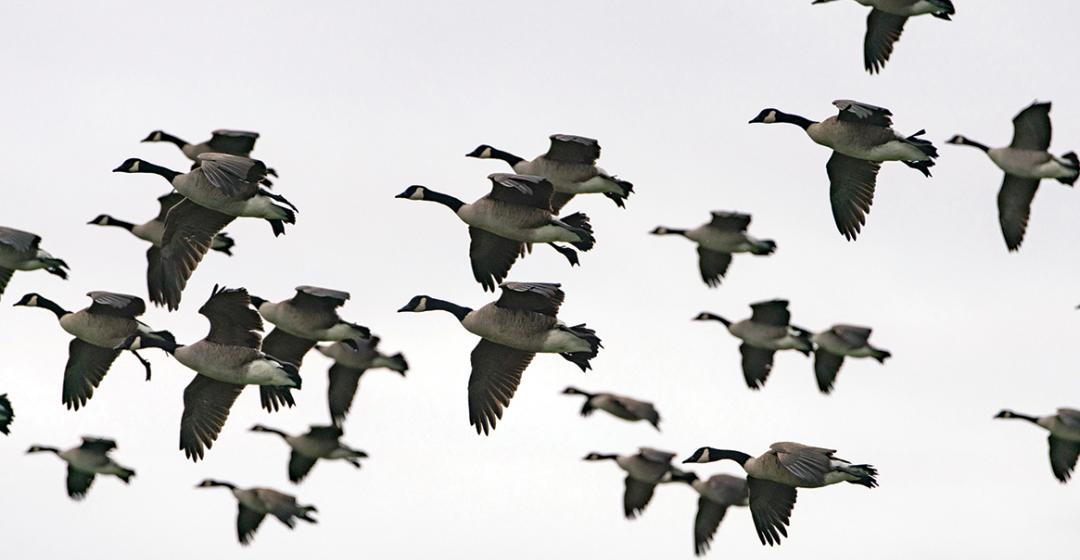Sitting in a makeshift goose blind in a cornfield in West Tisbury on a warm September morning, it is easy to think I ought to be fishing and not swatting at buzzing mosquitoes. My waterfowling senses are honed to blustery winds and gray skies, not summer warmth.
My hunting companion, builder Brian Welch of Oak Bluffs, and I carry on a muffled conversation. Having set out decoys in the field, we wait for geese to leave a nearby salt pond and hopefully fly into our field to feed.
We are among a small number of Island hunters inclined to participate in the Massachusetts early Canada goose season, intended to reduce non-migratory geese numbers. I see my presence as a public service, given my other options: I could be casting to bonito off Lobsterville; I could still be in bed.
Geese that have grown less wary over the preceding months and a generous daily bag limit of fifteen birds is the lure. When the regular goose season commences in mid-October, the limit will be two birds – small incentive to rise before dawn or give up a day of deer hunting.
The approximately three-week-long early goose season begins the day after Labor Day, and the sound of shotgun blasts booming across pastoral Island landscapes has been known to surprise shoulder season visitors unfamiliar with the Island’s waterfowling traditions. Emergency dispatchers at the Island’s communications center assure nervous callers that all is well.
Unlike their Canadian cousins, who briefly visit Massachusetts on their annual fall and spring migration, these birds do not know life on the distant wing. They are permanent residents of Island ponds and bays with easy grazing access to a buffet of lawns, parks, and farm fields. Many of these birds are actually descendants of captive geese waterfowlers once used to lure passing flocks within shotgun range. The practice was outlawed in the 1930s and the geese were simply set loose.
The Massachusetts Division of Fisheries and Wildlife (DFW) explains that with no pattern of migration, these geese began nesting in-state, something they had rarely done before that. In the 1960s and early 1970s, the DFW moved geese from the coast into central and western Massachusetts “to the applause of both hunters and non-hunters,” according to the division. A population explosion followed.
No one is applauding anymore. Certainly not the farmers.
Brian Athearn of West Tisbury, who serves as Martha’s Vineyard Agricultural Society president, says a flock of geese can uproot 20 percent of a newly planted crop in a day. “If a farmer goes in to plant winter rye, the first thing that happens is the geese root up the seeds then they eat all the fresh growth and kill it,” he says.
Runoff is also a concern. The average goose produces a half-pound to a pound-and-a-half of droppings every day. Putting aside the hazard to fastidious golfers, goose poop is a significant source of bacterial contamination and nitrogen loading in Island waterbodies, affecting shellfish and water quality.
Athearn says a coordinated effort is needed to reduce the resident goose population. Current state measures are just “not realistic.”
I agree. The state’s late winter hunting season and its daily limit of five birds is not available to the Cape and Islands.
H.W. Heusmann, veteran DFW waterfowl biologist, says the prohibition is in place to protect a depressed population of migratory birds from Labrador and Newfoundland. Heusmann says wildlife officials do not have sufficient data on
the actual mix of resident and wintering migratory birds to open the late season to the southern coastal district.
The Island’s annual Christmas bird count provides one measurement. In 2019, volunteer observers counted 2,419 geese. Even accounting for the migratory birds, I say bring back the winter season.
Cold winds are far from my mind as Welch and I watch the sun rise above a row of pine trees. The faint sound of geese honking interrupts our conversation. It grows louder. The natural urge is to stand and look. But experienced hunter Cooper “Coop” Gilkes has told me many times, “If you can see them, they can see you, and a whole lot better.”
I grip my ancient Browning Auto-5 twelve-gauge, a shotgun with a Chilmark lineage as rich as the Island’s gunning tradition. Peering between the corn stalks I see a flock of geese in V-formation etched against a blue sky and wait for my opportunity.





